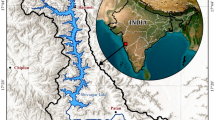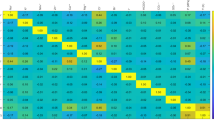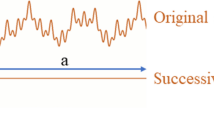Abstract
The paper presents application of a hybrid method of methane hazard prediction in exploited mine workings in coal mines. For prediction, the authors used so-called local linear models, the number of which is defined in an adaptive way, and the model of time series prediction ARIMA. The prediction task consists in generating the maximum predicted methane concentration value in a certain time horizon. This forecast is then used to define a methane hazard level by means of a fuzzy system of the Mamdami type. Another important issue covered by the paper is processing of row measurement data to an acceptable form using analytical method and adaptation of the model to changing environmental conditions. The experimental part of the paper presents results of data analysis completed for two longwalls.
Similar content being viewed by others
References
Bojko, B., The Analysis of Acquired Measurements of Methane Concentration in Mine Galeries-Selected Examples, Proc. of the 3rd School of Mine Ventilation, Zakopane, 2004 (in Polish).
Bojko, B., Dynamics of Methane Content in Mine Workings, Extended Abstract of PhD Dissertation, Polish Academy of Sciences, Strata Mechanics Institute, Cracow, 2004 (in Polish).
Nakayama, S., Uchino, K., and Inoue, M., Simulation of Methane Gas Distribution at a Heading Face, Journal of the Mining and Materials Processing Institute of Japan, 1998, vol. 114, no. 4.
Ushakov, K.Z., Gas Dynamics of Shafts, Moscow: Nauka, 1984.
Krause, E. and Łukowicz, K., Dynamic Prediction of Absolute Methane Emissions to Extraction Panels, Proc. of the 29th Int. Conf. of Safety in Mines Research Institutes, 2001, Szczyrk, Poland, vol. 1 (in Polish).
Kurnosow, W.G. and Krasik, J.L., Methane Hazard and Its Monitoring, Proc. of the 7th Int. Mine Ventilation Congress, 2001, Cracow, Poland.
Dixon, W.D., A Statistical Analysis of Monitored Data for Methane Prediction, Extended Abstract of PhD Dissertation, University of Nottingham, Dept. of Mining Engineering, 1992.
Firganek, B., Stochastic Model of Methane Emission in Longwall Faces, Proc. of the 29th Int. Conf. of Safety in Mines Research Institutes, 2001, Szczyrk, Poland, vol. 1 (in Polish).
Wasilewski, S., Analysis of the Measurement Signals of Ventilation Processes, Mining Automation Bulletin, 1986, no. 31 (in Polish).
Sikora, M. and Sikora, B., Application of Machine Learning for Prediction of Methane Concentration in a Coal-Mine, Archives of Mining Sciences, 2006, vol. 51,issue 4.
Sikora, M., Krzystanek, Z., Bojko, B., and Spiechowicz, K., Hybrid Adaptative System of Gas Concentration Prediction in Hard-Coal Mines, Proc. of the 19th Int. Conf. on Systems Engineering, IEEE Computer Society (CPS), 2008, Las Vegas, Nevada, USA.
Krzystanek, Z., Dylong, A., and Wojtas, P., Monitoring of Environmental Parameters in Coal Mine-The SMP-NT System, Mechanizacja i Automatyzacja Górnictwa, 2004, no. 9.
Gralewski, K. and Krzystanek, Z., New Features of the SMP/NT System for Environmental Hazard Monitoring in Coal Mines, Mechanizacja i Automatyzacja Górnictwa, 2004, no. 9.
Box, G. E. P. and Jenkins, G.M., Time Series Analysis: Forecasting and Control, New Jersey: Prentice Hall, 3th edition, 2004.
Czogała, E. and Łęski, J. Fuzzy and Neuro-Fuzzy Intelligent Systems, Studies in Fuzziness and Soft Computing, 2000, vol. 47, Springer-Verlag Company.
Breiman, L., Friedman, J.H., Olshen, R.A., and Stone, C.J., Classification and Regression Trees, Wadsworth, Belmont CA, 1994.
Quinlan, J.R., Learning with Continuous Classes, Proc. Int. Conf. on Artificial Intelligence (AI`92), Singapore, World Scientific, 1992.
Quinlan, J.R., Combining Instance-Based Learning and Model-Based Learning, Proc of the 10th Int. Conf. on Machine Learning (ML-93), 1993.
Knuth, D.E., The Art of Computer Programming, vol. 3, Sorting and Searching, Addison-Wesley, 1998.
Quinlan, J.R., C4.5 Programs for Machine Learning, Morgan Kaufman Publishers, San Mateo, California, 1992.
Witten, I.H and Frank, E., Data Mining: Practical Machine Learning Tools and Techniques, Morgan Kaufman, 2005.
Grychowski, T., Hazard Assessment Based on Fuzzy Logic, Archives of Mining Sciences, 2008, vol. 53, no. 4
Yager, R.R. and Filev, D.P., Essential of Fuzzy Modelling and Control, John Wiley & Sons, Inc, 2004.
Statistica 8.0 (www.statsoft.com).
Matlab 2009 (www.mathworks.com).
Oh, S.K., Pedrycz, W., and Park, H.S., Rules Based Multi-FNN Identification with the Aid of Evolutionary Fuzzy Granulation, Knowledge-Based Systems, vol. 17, 2004.
Author information
Authors and Affiliations
Corresponding author
Additional information
__________
Translated from Fiziko-Tekhnicheskie Problemy Razrabotki Poleznykh Iskopaemykh, No. 4, pp. 3–10, July–August, 2011.
Rights and permissions
About this article
Cite this article
Sikora, M., Krzystanek, Z., Bojko, B. et al. Application of a hybrid method of machine learning for description and on-line estimation of methane hazard in mine workings. J Min Sci 47, 493–505 (2011). https://doi.org/10.1134/S1062739147040125
Received:
Published:
Issue Date:
DOI: https://doi.org/10.1134/S1062739147040125




